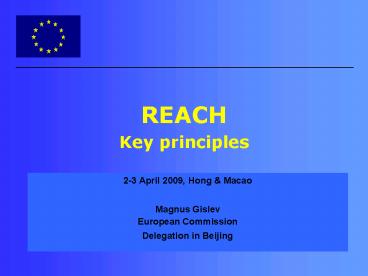REACH Key principles - PowerPoint PPT Presentation
1 / 18
Title:
REACH Key principles
Description:
in particular for less hazardous substitutes. European Commission. REACH: Goals ... http://ec.europa.eu/environment/chemicals. http://ec.europa.eu/enterprise/chemicals ... – PowerPoint PPT presentation
Number of Views:42
Avg rating:3.0/5.0
Title: REACH Key principles
1
REACHKey principles
- 2-3 April 2009, Hong Macao
- Magnus Gislev European Commission
- Delegation in Beijing
2
Contents
- Background
- From authority to industry responsibility
- Key elements REACH
- Registration
- Evaluation
- Autorisation
- Restriction
- Implementation timetable
- Conclusion
3
Background
- Chemicals industry in EU 30,000 companies
- 1.9 million employees
- Up to 1981 100,106 existing chemicals on EU
inventory - Since 1981 another 4,000 new chemicals
4
Old EU legislation
- Existing substances could be used without testing
- lack of knowledge about their properties and uses
- Burden of proof was on public authorities
- Old system slow to act
- no efficient instrument to deal with problematic
substances - Lack of incentives for innovation
- in particular for less hazardous substitutes
5
REACH Goals
- Protect health and safety
- Protect environment
- Maintaining a competitive/innovative chemicals
industry - To reach goals industry must provide the data
6
More responsibility for industry
- Industry to demonstrate safety of chemicals
- Properties of substances
- Use of substances
- Risk assessment
- Risk management
- Why? Those who manufacture and use the
substances have easier access to information than
authorities
7
REACH
- Regulation (EC) No 1907/2006 of the European
Parliament and of the Council of 18 December 2006
on the Registration, Evaluation and the
Authorisation of Chemicals - Scope
- manufacture, import, placing on market and use
of substances (on their own, in preparations or
in articles)
8
Key elements of REACH
- Registration of substances 1 tonne/yr
- Evaluation of some substances
- Authorisation only for substances of very high
concern - Restrictions - the safety net (EU action)
- Agency to efficiently manage system
Focus on priorities Substances with high
volumes and those of greatest concern!
9
Registration (1)
AIM Ensure industry adequately manages risks
from substances
- Registration
- Tonnage based
- Applies to chemicals manufactured in the EU
and/or their importation - Registration deadlines 2010, 2013, 2018
- Industrys responsibility
10
Registration (2)
Information and Communication
Industry obtains and communicates the necessary
information to adequately control the risks
- Registration by manufacturers and importers
- Collect information up and down the supply chain
- Assess information
- If volumes gt10 tonnes, assess the risks and
determine appropriate risk management measures - Communicate results down the supply chain
- Registration is the documentation that the above
obligations have been carried out.
11
Pre-registration
Aim Sharing of information
- Pre-registration
- Manufacturers and importers
- 1 June 2008 until 1 December 2008
- Extended deadlines for registration
- Data sharing
12
Evaluation
industry is meeting obligations Prevent
unnecessary testing
Aim Check if more information is needed
- Dossier evaluation
- By the European Chemicals Agency (ECHA)
- Examination of testing proposals
- Compliance check
- Substance evaluation
- By EU Member States competent authorities
- Rolling plans with substance prioritisation
- Follow-up suspicion of risk request more info
- Authorities responsibility
13
Authorisation
Aim Ensure risks from substances of very high
concern are properly controlled
- Applies to
- Substances of very high concern (SVHC) (CMR, PBT,
vPvB, scientific evidence of probable serious
effects) - Substance, substance in preparation (unless below
concentration limit), substance incorporated into
an article - Substance cannot be used unless authorised
- Substances progressively authorised
- Downstream users can use suppliers authorisation
14
Restrictions
Aim act as safety net
- EU-wide concern
- EU Member States and European Commission initiate
- ECHA Committees examine
- Risk
- Socio-economic aspects
- European Commission - final decision
- Carry-over of existing restrictions from previous
legislation
- European Commissions responsibility
15
Data sharing
- Data sharing mechanisms of REACH
- avoid unnecessary testing, while generating
necessary information to identify hazards and
manage risks of substances - avoid animal testing, tests on vertebrate animals
as a last resort only - reduce costs to industry
- Inquiry and Substance Information Exchange Forums
(SIEFs)
16
REACH timeline
- June 2007 - Entry into force of REACH
- June 2008 - Agency operational
- Pre-registration until 1 December 2008
- - Registration begins
- June 2009 - First substances prioritised for
authorisation - June 2010 - New restrictions
- End 2010 - First registration deadline for 1000t
CMR - End 2018 - Last registration deadline for 1t
17
Conclusions
- REACH aims for better health and safety and
environmental protection - Industry responsibility demonstrated at
registration - Key role for European Chemicals Agency and Member
States authorities - Governments can tack action to control dangerous
substances
18
More Information
Thank you!
http//echa.europa.euhttp//ec.europa.eu/environm
ent/chemicals http//ec.europa.eu/enterprise/chem
icals































